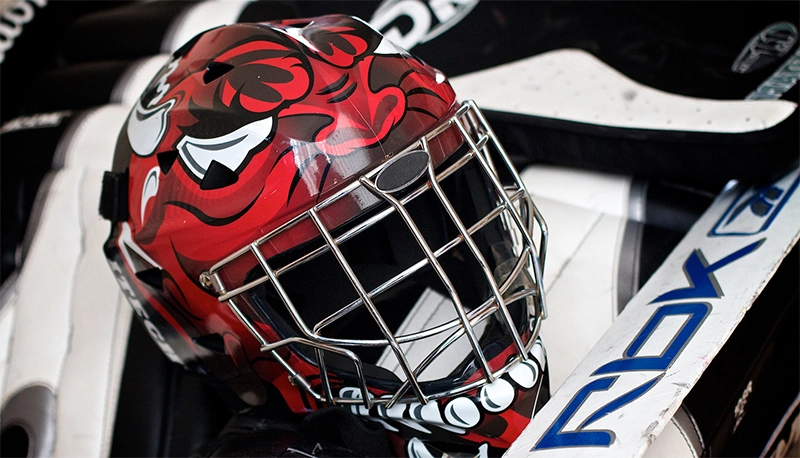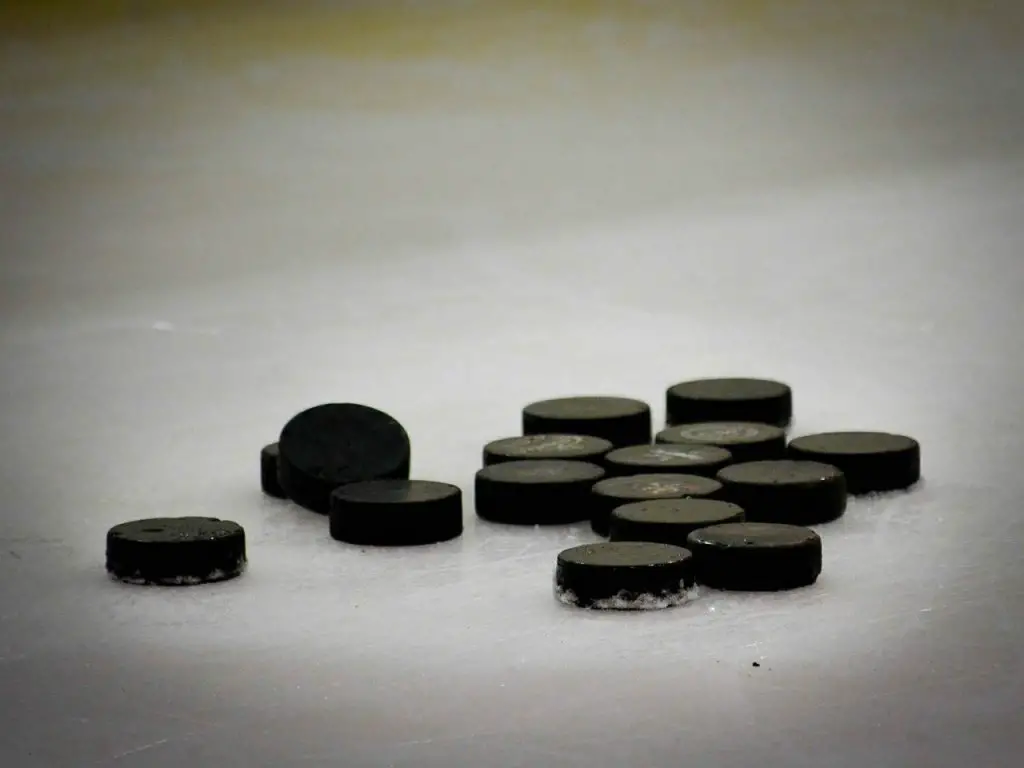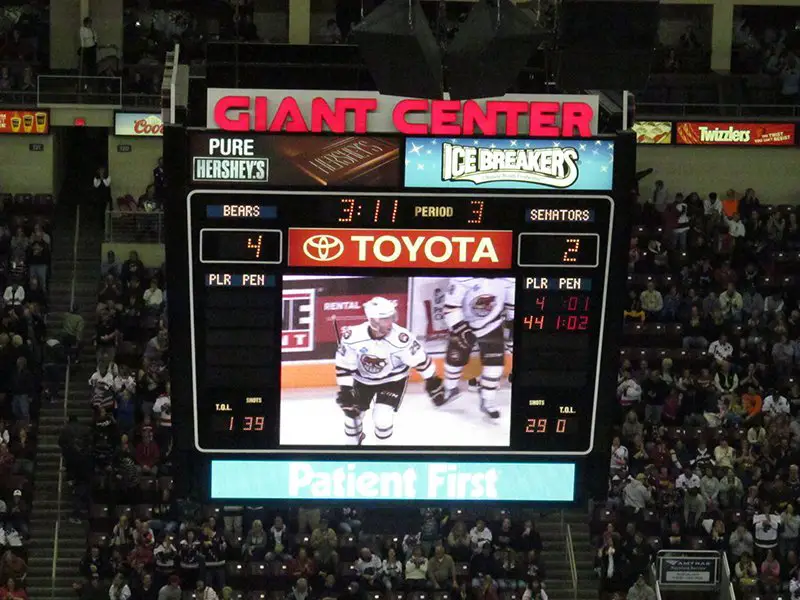Being a hockey goalie is a job few will sign up for, but for those who do, they wouldn’t have it any other way.
As a former goalie, I’m going to use my inside knowledge to help you get a better understanding around hockey goalie equipment, and hopefully answer some of your questions and concerns.
Let’s get into it!
Table of Contents
Gear used by goalies in hockey
Goalies in hockey require specialty hockey equipment that no other player on the ice wears. This is because they face the nightly challenge of stopping hard frozen rubber pucks flying up to 100 mph towards them.
Equipment worn by goalies in hockey include; mask, dangler, neck guard, chest protector, catching glove, blocker, goalie pants, jockstrap, pads, skates and a stick. Dangler’s and neck guards are optional at adult levels of hockey and mandatory at youth levels.
Let’s take a closer look at the type of gear goalies wear to protect themselves on a nightly basis.
Mask
Ice hockey goaltenders wear helmets just like every other player on the ice. However, their helmets are commonly referred to as masks and take a different shape than regular players helmets.
Goalie masks may look a little different in youth and high school hockey than they do in the National Hockey League or other professional hockey leagues. This is because many professional goalies wear what are referred to as “cat eye cages” on their masks.

These specialty cages bend the cage bars around the eye as opposed to running straight across like gride cages. This provides the goalie with better vision on the ice while still being able to protect against a hockey puck entering the cage. However, goalies with cat eye cages are more susceptible to getting an accidental stick to the eye.
In youth and high school hockey, cat eye cages are illegal. This rule was put in place to protect young goalies from receiving an accidental stick to the eye.
Dangler (throat guard)
From minor hockey all the way to the NHL you will see goalies wearing Danglers.
Danglers are a contoured piece of hardened plastic that hangs from a goalie masks, also referred to as throat guards they are used in protecting goalies from being hit in the throat with a puck.
Some goalies in professional hockey opt not to use Danglers, mainly because players at a higher level have more control in their shots reducing the risk of being hit in the neck or throat area. They can also become an annoyance or a distraction if you aren’t used to wearing one.
Me personally, I would never hit the ice without one. I can’t even count the amount of times my dangler has protected me from a dangerously fast shot that would almost certainly hit my throat without one. Also, I’ve been wearing one since timbits hockey, so I’m very used to it.
Parents out there, if your kid want’s to be a hockey goalie, I highly recommend equipping them with one.
Neck Protector
Neck protectors do exactly as they sound, they protect your neck. These ergonomic neck collars protect your neck from taking damage from an errant puck. Some models even come with wings that branch out to protect your collar bones as well.
This is another piece of hockey padding that you will see at all levels of minor hockey but not so much throughout professional hockey as at those higher levels of play it comes down to personal preference.
Some goalies in the NHL will wear both a neck guard and a dangler, some choose one or the other, and others will choose to wear neither.
Chest Protector
Possibly one of the most important pieces of goalie equipment, a chest protector provides ample additional padding and is a piece of gear that protects goalies when a slap shot comes barreling in on them at up to 100 miles per hour.

Vaughn, an uber popular hockey equipment manufacturer, is especially known for their chest protectors. Their Ventus SLR2 Pro model is used by many goalies in the NHL and across other professional leagues, as it provides ample protection while also being fairly lightweight compared to other models.
Youth goalie chest protector sizing chart
Adult goalie chest protector sizing chart
Catching Glove (trapper)
Goalies catching gloves are one of the most vital pieces of equipment they own.
The catching glove, also commonly referred to as a trapper, is what ice hockey goalies use to catch the puck out of midair or to freeze the puck.
Other than that, a goalie’s trapper is also meant to protect their hands.
Scrambles in front of the net can be chaotic and sometimes goalie have their hands stepped on or hit with opposing player’s sticks, this is why catching gloves need to have additional padding to protect the goalies hand.
Blocker
Unlike other positions, goalies require two different types of gloves. The catching glove, and the blocker.
Goalie blockers are made from a strong material to prevent frequent hand injuries.
Blockers are worn on the hand which holds the goalie stick and are used during games to deflect pucks away from the net and sometimes as a weapon against the opposing players in front of the net (I’m guilty of this from time to time).
Goalie Pants
You may think that goalie pants and everyday hockey pants are the same thing simply by looking at them, however this isn’t the case.
The thigh just above a goalies pads is frequently peppered by pucks throughout a game. Goalie pants provide far more padding in the front, protecting their thighs and groins from opposing players shots.
Jockstrap
Pretty self-explanatory, like other skaters, goalies wear jockstrap’s to protect the family jewels.
Goalie Pads
Every goalies pride and joy other than their custom painted goalie mask are their pads. Goalie pads can make a gear nerd out of the best of us.
When it comes to purpose, a pair of goalie pads are quite possibly the most important piece of gear a goalie has.
Goalie pads are the focal point of any goaltender. They are used to protect the bottom half of the net and are great tools to redirect rebounds into either side of the ice.
Goaltenders rely on their pads to slide back and forth across their crease, which is why many (myself included) opt for lightweight goalie pads.
Skates
Every player on the ice wears a pair of skates to help them maneuver. But goalie skates are not exactly the same as regular player skates.
Goaltender skates come equipped with special blades designed specifically for goaltending. These blades are longer and narrower than standard skate blades. This allows the goalkeeper to move faster through the crease without sacrificing control.
Goalie skates have more shell like padding to protect against the impact of pucks, whereas player skaters are less protected and more flexible.
Skates that hockey goalies wear also don’t come up over the ankle, making it easier for goalies to be more shifty in their crease.
Sticks
Sticks that goaltenders use are far different from the ones regular players use. For starters, goalies only hold their sticks with one hand.
The most important thing that goalies rely on their sticks for is stability. Have you ever seen a goalie play without their stick? It’s not a pretty sight.
Naturally, goalie sticks are also thicker than player sticks. They also have a larger blade area for better control of the puck.
How much does hockey goalie equipment cost?
Being a goalie in hockey is the most expensive position to play in the sport.
Goalies require different equipment than regular skaters, and it comes with added costs. The cost of goalie equipment will vary depending on if you are buying for youth, junior, intermediate or senior.
But how much will it cost you to buy a complete set of goalie gear? You can expect to spend between $800-$1,200 for youth goalie equipment, $1,100-$1,500 for junior goalie equipment, $1,400-$2,000 for intermediate goalie equipment and $1,700-$2,300 for senior goalie equipment.
Of course, you can cut costs down considerably by opting to buy second hand. When I first started playing goalie, my dad got my blocker, trapper and stick from a garage sale and the rest of my gear was used from the local arena.
Nowadays, there are great places to save money on goalie equipment, sidelineswap.com for example.
Below, I have gathered data and put together charts showing the lowest prices I found online for all new goalie equipment across all age groups.
Youth goalie equipment price guide
Total cost of youth goalie equipment: $994.89
Junior goalie equipment price guide
Total cost of junior goalie equipment: $1,284.89
Intermediate goalie equipment price guide
Total cost of intermediate goalie equipment: $1,673.89
Senior goalie equipment price guide
Total cost of senior goalie equipment $1,734.89
All prices were gathered using the lowest possible prices found on sourceforsports.com and goalie.purehockey.com.
How much does hockey goalie equipment weigh?
The extra gear goalies wear to better protect themselves against speeding pucks and the weight definitely adds up. I can tell you from experience, by the end of a game you just want to get it all off as quick as possible.
Goalie equipment is heavy. Depending on the size of the goalie, his or her equipment can weigh between 30-60 pounds. The weight comes from all the extra padding goalies require to protect themselves while stopping pucks.
Furthermore, when goalie gear gets soaked in sweat during a game, it can increase the weight. This is why goalies are always so fit.
Should you buy new or used goalie equipment?
Being a goalie is fun, but when you see the total cost of buying all new goalie gear, it can be pretty intimidating. This is often where people opt to go out and purchase used equipment, but should you?
There is nothing wrong with buying used goalie equipment, for the most part. Things you should avoid are buying used helmets and sticks. When buying used chest protectors, ensure that all padding is still intact.
Helmets are key in protecting that beautiful head of yours and if you buy used helmets you could be buying a defective or compromised helmet without knowing. Buying a new mask is the peace of mind that protects your mind.
Sticks take a beating during games and practice, if you buy used sticks they are likely to break rather quickly. In the long run you would be better off biting the bullet on a brand-new stick that should last you a decent amount of time.
Buying new goalie gear stinks (ok, it’s fun but hurts the wallet), but buying used goalie equipment stinks more, literally.
Before you make a purchase of used goalie equipment, be sure to give it a good sniff or two. If it smells unbearably bad when dry, you can only imagine what it will smell like when drenched in sweat. Now, most used gear will smell slightly off, but you will know when the smell is TOO FOUL.
What are the lightest goalie pads?
Goalies are always looking for ways to cut down on the weight of their gear to improve their agility. I’m guilty of this myself, which is why I know exactly who makes the lightest goalie pads on the market.
Sports equipment company “Warrior” currently offers the lightest goalie pads on the market. With their lightest model, warrior ritual G4 weighing in at just 4 lbs (size 34+1). Bauer hockey isn’t far behind, their Vapor 2X model weighs just 4.4 lbs (size 34+1).
So, if you’re looking for lighter pads, your best bet is going to be with either Warrior or Bauer. Of course, you should remember the bigger you are the bigger your pads will be which means more weight.
Final thoughts
Being a goalie is a lot of fun, but at the same time, it can get really expensive.
However, buying new gear isn’t always the only route you have to go, buying used is always a great option to save you money.
I hope I was able to solve any concerns you may have had about goalie equipment, I know it can be an overwhelming topic when first starting out.
Game on!





